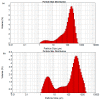Extraction and Characterization of Potential Biodegradable Materials Based on Dioscorea hispida Tubers
- PMID: 33672030
- PMCID: PMC7919467
- DOI: 10.3390/polym13040584
Extraction and Characterization of Potential Biodegradable Materials Based on Dioscorea hispida Tubers
Abstract
This study was driven by the stringent environmental legislation concerning the consumption and utilization of eco-friendly materials. Within this context, this paper aimed to examine the characteristics of starch and fibres from the Dioscorea hispida tuber plant to explore their potential as renewable materials. The extraction of the Dioscorea hispida starch and Dioscorea hispida fibres was carried out and the chemical composition, physical, thermal, morphological properties, and crystallinity were studied. The chemical composition investigations revealed that the Dioscorea hispida starch (DHS) has a low moisture t (9.45%) and starch content (37.62%) compared to cassava, corn, sugar palm, and arrowroot starches. Meanwhile, the Dioscorea hispida fibres (DHF) are significantly low in hemicellulose (4.36%), cellulose (5.63%), and lignin (2.79%) compared to cassava, corn hull and sugar palm. In this investigation the chemical, physical, morphological and thermal properties of the Dioscorea hispida fibre and Dioscorea hispida starch were examined by chemical composition investigation, scanning electron microscopy (SEM), particle size distribution, thermogravimetric analysis (TGA), X-ray powder diffraction (XRD), and Fourier transform infrared (FTIR), respectively. It was found that Dioscorea hispida waste is promising alternative biomass and sustainable material with excellent potential as a renewable filler material for food packaging applications.
Keywords: Dioscorea hispida tubers; natural fibres; polymer from renewable source; starch; sustainable materials.
Conflict of interest statement
The authors declare no conflict of interest.
Figures






Similar articles
-
Effect of plasticizers on physical, thermal, and tensile properties of thermoplastic films based on Dioscorea hispida starch.Int J Biol Macromol. 2021 Aug 31;185:219-228. doi: 10.1016/j.ijbiomac.2021.06.099. Epub 2021 Jun 18. Int J Biol Macromol. 2021. PMID: 34153358
-
Modified Dioscorea hispida starch-based hydrogels and their in-vitro cytotoxicity study on small intestine cell line (FHS-74 Int).Int J Biol Macromol. 2018 Feb;107(Pt B):2412-2421. doi: 10.1016/j.ijbiomac.2017.10.125. Epub 2017 Oct 19. Int J Biol Macromol. 2018. PMID: 29056465
-
Physicochemical Properties of Starch from Dioscorea pyrifolia tubers.Food Chem. 2017 Apr 1;220:225-232. doi: 10.1016/j.foodchem.2016.09.196. Epub 2016 Sep 30. Food Chem. 2017. PMID: 27855893
-
Recent advances in sago (Metroxylon sagu) fibres, biopolymers, biocomposites, and their prospective applications in industry: A comprehensive review.Int J Biol Macromol. 2024 Jun;269(Pt 1):132045. doi: 10.1016/j.ijbiomac.2024.132045. Epub 2024 May 4. Int J Biol Macromol. 2024. PMID: 38710254 Review.
-
Sugar Palm Fibre-Reinforced Polymer Composites: Influence of Chemical Treatments on Its Mechanical Properties.Materials (Basel). 2022 May 27;15(11):3852. doi: 10.3390/ma15113852. Materials (Basel). 2022. PMID: 35683149 Free PMC article. Review.
Cited by
-
Extraction and Characterization of Natural Cellulosic Fiber from Pandanus amaryllifolius Leaves.Polymers (Basel). 2021 Nov 29;13(23):4171. doi: 10.3390/polym13234171. Polymers (Basel). 2021. PMID: 34883674 Free PMC article.
-
Utility Assessment of Isolated Starch and Extract from Thai Yam (Dioscorea hispida Dennst.) for Cosmetic via In Vitro and In Vivo Studies.Life (Basel). 2025 Jan 22;15(2):151. doi: 10.3390/life15020151. Life (Basel). 2025. PMID: 40003560 Free PMC article.
-
Development and Characterization of Cornstarch-Based Bioplastics Packaging Film Using a Combination of Different Plasticizers.Polymers (Basel). 2021 Oct 11;13(20):3487. doi: 10.3390/polym13203487. Polymers (Basel). 2021. PMID: 34685246 Free PMC article.
-
Characterization of Polylactic Acid Biocomposites Filled with Native Starch Granules from Dioscorea remotiflora Tubers.Polymers (Basel). 2024 Mar 25;16(7):899. doi: 10.3390/polym16070899. Polymers (Basel). 2024. PMID: 38611157 Free PMC article.
-
Recent advances in green technology and Industrial Revolution 4.0 for a sustainable future.Environ Sci Pollut Res Int. 2023 Dec;30(60):124488-124519. doi: 10.1007/s11356-022-20024-4. Epub 2022 Apr 9. Environ Sci Pollut Res Int. 2023. Retraction in: Environ Sci Pollut Res Int. 2024 Jul;31(33):46125. doi: 10.1007/s11356-024-34311-9. PMID: 35397034 Free PMC article. Retracted. Review.
References
-
- Ilyas R.A., Sapuan S.M., Ibrahim R., Abral H., Ishak M.R., Zainudin E.S., Atikah M.S.N., Mohd Nurazzi N., Atiqah A., Ansari M.N.M., et al. Effect of sugar palm nanofibrillated celluloseconcentrations on morphological, mechanical andphysical properties of biodegradable films basedon agro-waste sugar palm (Arenga pinnata (Wurmb.) Merr) starch. J. Mater. Res. Technol. 2019;8:4819–4830. doi: 10.1016/j.jmrt.2019.08.028. - DOI
-
- Sapuan S.M., Aulia H.S., Ilyas R.A., Atiqah A., Dele-Afolabi T.T., Nurazzi M.N., Supian A.B.M., Atikah M.S.N. Mechanical properties of longitudinal basalt/woven-glass-fiber-reinforced unsaturated polyester-resin hybrid composites. Polymers. 2020;12:2211. doi: 10.3390/polym12102211. - DOI - PMC - PubMed
-
- Jumaidin R., Sapuan S.M., Jawaid M., Ishak M.R., Sahari J., Sapuan S.M., Jawaid M., Ishak M.R., Sahari J. Characteristics of Eucheuma cottonii waste from East Malaysia: Physical, thermal and chemical composition. Eur. J. Phycol. 2017;52:200–207. doi: 10.1080/09670262.2016.1248498. - DOI
Grants and funding
LinkOut - more resources
Full Text Sources
Other Literature Sources

